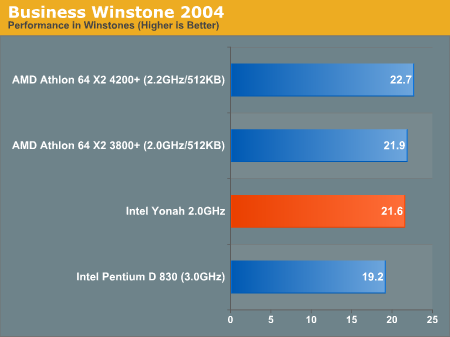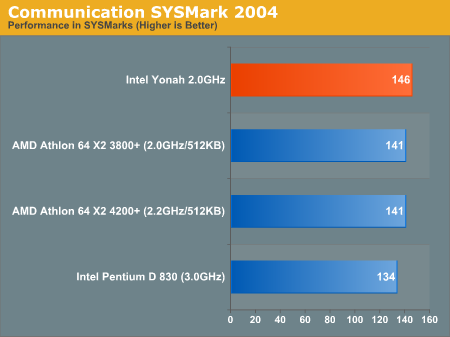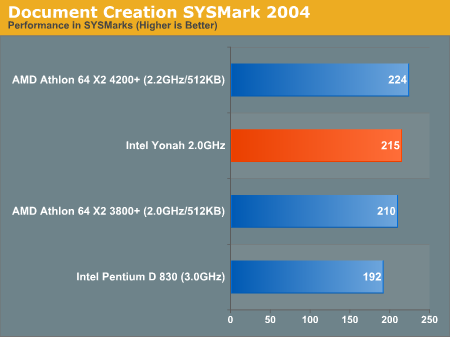Intel Yonah Performance Preview - Part I: The Exclusive First Look at Yonah
by Anand Lal Shimpi on November 30, 2005 2:50 AM EST- Posted in
- CPUs
The Test
Our test configuration is identical to what we used in our Athlon 64 X2 3800+ review, however we can’t disclose the motherboard used for the Yonah platform. We can say that it used the Intel 945G chipset and was outfitted with 2 x 512MB DDR2-533 DIMMs; the rest of the configuration remained the same as the AMD and Intel systems.
Once again, keep in mind that the platform and processor are pre-release samples, and performance could change by the time the parts head to retail. This is nothing more than a preview, so treat it as such.
Business Winstone 2004
Business Winstone 2004 tests the following applications in various usage scenarios:
. Microsoft Access 2002
. Microsoft Excel 2002
. Microsoft FrontPage 2002
. Microsoft Outlook 2002
. Microsoft PowerPoint 2002
. Microsoft Project 2002
. Microsoft Word 2002
. Norton AntiVirus Professional Edition 2003
. WinZip 8.1

Just as we saw in the Dothan vs. Yonah tests, Yonah loses some of its competitive edge in the Business Winstone benchmark. Although in this case, it's not very far off the Athlon 64 X2 3800+.
Office Productivity SYSMark 2004
SYSMark's Office Productivity suite consists of three tests, the first of which is the Communication test. The Communication test consists of the following:
"The user receives an email in Outlook 2002 that contains a collection of documents in a zip file. The user reviews his email and updates his calendar while VirusScan 7.0 scans the system. The corporate web site is viewed in Internet Explorer 6.0. Finally, Internet Explorer is used to look at samples of the web pages and documents created during the scenario."

Yonah manages to be quite competitive in the SYSMark tests, slightly outpacing the Athlon 64 X2 4200+ here.
The next test is Document Creation performance, which shows very little difference in drive performance between the contenders:
"The user edits the document using Word 2002. He transcribes an audio file into a document using Dragon NaturallySpeaking 6. Once the document has all the necessary pieces in place, the user changes it into a portable format for easy and secure distribution using Acrobat 5.0.5. The user creates a marketing presentation in PowerPoint 2002 and adds elements to a slide show template."

Here we see that at 2.0GHz, Intel's Yonah is right in the middle of AMD's Athlon 64 X2 4200+ and the X2 3800+. Given that the CPU has no on-die memory controller, yet performs comparably to an identically clocked Athlon 64 X2, it's not a bad position to be in for Yonah.
The final test in our Office Productivity suite is Data Analysis, which BAPCo describes as:
"The user opens a database using Access 2002 and runs some queries. A collection of documents are archived using WinZip 8.1. The queries' results are imported into a spreadsheet using Excel 2002 and are used to generate graphical charts."

The Data Analysis test is dominated by the Pentium D, but even the Athlon 64 X2 3800+ holds a slight advantage over the 2.0GHz Yonah.










135 Comments
View All Comments
stupid - Wednesday, November 30, 2005 - link
Since the closest CPU AMD has that is similar the Yonah is the Athlon 64 X2 3800+ I figured it may be interesting to see how the Yonah would compare to the Athlon 64 X2 3800+ when using the 65nm process. This will happen next year, but I figure crunching some numbers now may shed some light as to its possible performance in terms of TDP and power consumption. My calculations are simply conjecture and I am pretty sure it will raise questions regarding their validity. I must point out that I am not an electrical engineer, and I assume that calculations would be linear.So let's begin. First off, I will start by crunching numbers for the die shrink for the single core Athlon 64 from 130nm to 90nm. Why? Because the Athlon 64 X2 was introduced using the 90nm process. Going from 130nm to 90nm is a 30.77% reduction in size. A 130nm Athlon 64 has a TDP of 89, and a 90nm Athlon 64 has a TDP of 67. This is a reduction of 24.72%. So the decrease to TDP is about 80% of the physical die shrink. This is a baseline number used for the next series of calculations.
Okay, let's look at what might happen when the Athlon 64 X2 is shrunk from 90nm to 65nm. Going from 90nm to 65nm represents a 27.78% reduction in physical size (assuming nothing else is added to the core). The Athlon 64 X2 3800+ has a TDP of 89 (all other Athlon X2 has a TDP of 110), if it can be assumed from above that the reduction in TDP is 80% of the physical decrease, then 80% of 27.78% is about 22.22%. This means that the TDP will drop from 89 to 69. Let me make a dangerous assumption that power consumption will decrease by the same percentage TDP would decrease by. So a 22.22% reduction in power consumption would mean that going from 90nm to 65nm Total System Power when idle is estimated to be 85 watts, and under load would be about 112 watts.
Summary:
Yonah: Idle - 92 watts, Load - 108 watts
Athlon 64 X2 3800+ (65nm): Idle - 85 watts, Load - 112 watts
So what does this all mean?
When the desktop Athlon 64 X2 3800+ is migrated to the M2 socket and the 65nm process is applied, it's power consumption may be very close to that of Intel's mobile CPU the Yonah. Thus, a mobile version of the 65nm X2 3800+ could mean better thermal, and power consumption performance than the Pentium M.
Let me just repeat again, all this is based on simple calculations that does not take into account potential variables in the real world.
LET THE FLAMING BEGIN !!!!!!!!!!!!!!!!!
forPPP - Thursday, December 1, 2005 - link
Completely false assumption.Yonah idle = 92 W. Do you really think 92 W in ile for notebook is possible. Provided in article power usage is not for CPU but a few components. You should rather recalculate by assuming that at idle CPU takes 0 W.
So:
Yonah = 109 - 92 = 17 W (+ true idle, how much can it be 3-5 W ?)
Athlox X2 = 144 - 109 = 35 W (+ true idle, 10-15W ?)
22% reduction for 65 nm and you got 28 W, almost 65% more than Yonah. Taking into account proposed idle usage it's stil 50% more than Yonah.
But Turion use less power than Athlon 64, mostly because it's clocked lower (and can have lowe voltage).
I suposse Turion Dual 1.8 GHz will be at the same TDP as Yonah 2.13 GHz.
Furen - Wednesday, November 30, 2005 - link
Actually, even though going from 130nm to 90nm is about a 30% feature size reduction, the actual die size redution is closer to 50%. This is because each transistor is shrunk close to 30% in each of its two dimensions, meaning that it'll have about 49% of the area of a pre-shrink transistor (70% x 70% = 49%, though this is not absolutely exact). In truth going from the 144 sq mm Newcastle to the 84 sq mm Venice gives you a die-size reduction of around 42%, which makes sense considering that you can't shrink everything in proportion to the feature size. I would expect the 65nm die shrink to offer similar or slightly worse size reduction.Shintai - Wednesday, November 30, 2005 - link
Let me give you a hint. Remove the hueg GFX card etc before doing your calculations. A hint for you is that Yonah idle comsumes around 1-3W depending on speedstep setting.Anyway, you need to do better homework since your math is flawed by other systemcomponents :P
stupid - Wednesday, November 30, 2005 - link
I can understand that you want to only look at the power consumption of the CPU. However, the article does not provide a breakdown of power consumption used by each individual component. I've also stated that my calculation will be linear, so yes the results are a bit skewed.The calculations are meant to be quick and dirty, not scientific.
xenon74 - Wednesday, November 30, 2005 - link
Hm, you and all other are forgetting that Turion uses Athlon64 architecture BUT with different type of transistors for mobile use, that consumes even less power. Based on that, my approximation goes as follows:90nm Athlon64 3500+ @ 2,2GHz is in 67W TDP envelope, E4 rev
90nm Athlon64 X2 4200+ @ 2,2GHz is in 89W TDP envelope, E4 rev
Thats 43% increase in TDP for second core (or 22W). Both CPU's are using the same voltage.
90nm Turion64 MT-40 @ 2,2GHz is in 25W TDP envelope, E5 rev, 1,2V_core
I speculate that dual core Turion64 will be:
90nm Turion64 X2 MT-40 @2,2GHz in 36W TDP envelope.
stupid - Wednesday, November 30, 2005 - link
Yes, the Turion uses transistors that are more gear towards reducing power consumption whereas an Athlon uses transistors that are geared more towards performance. But you need to realize that the article is comparing the Yonah to the Athlon 64 X2 3800+ and not the Turion.Yonah cannot be compared directly to the Turion because that is comparing a dual core CPU to a single core CPU.
The point of my post is not to compare Intel's mobile solution to AMD's next mobile solution. It is to emphasize that given a mere die shrink AMD's dual core CPU based on the 65nm process is potentially almost as energy efficient as Intel's dual core mobile CPU. If this is true then you can make the assumption that a dual core Turion will be even more effiencent than the Yonah because the dual core Turion will most likely be based off of an already efficient desktop CPU, and will have transistors that are geared towards power consumption efficiency rather than performance.
Do you follow?
xenon74 - Thursday, December 1, 2005 - link
Yes it can be and was in a TDP manner! :P
I cannot compare future mobile chip to noexistent desktop X2 chip (there will be no Athlon64 3800+ X2 in 65nm, maybe Sempron). But I do understand your emphasization and assumption.
crotale - Wednesday, November 30, 2005 - link
What was the FSB for the Yonah platform in this test?Donegrim - Wednesday, November 30, 2005 - link
I don't think they said, but I think all DC Yonahs are 667 (quad 166), which is a bit slow.